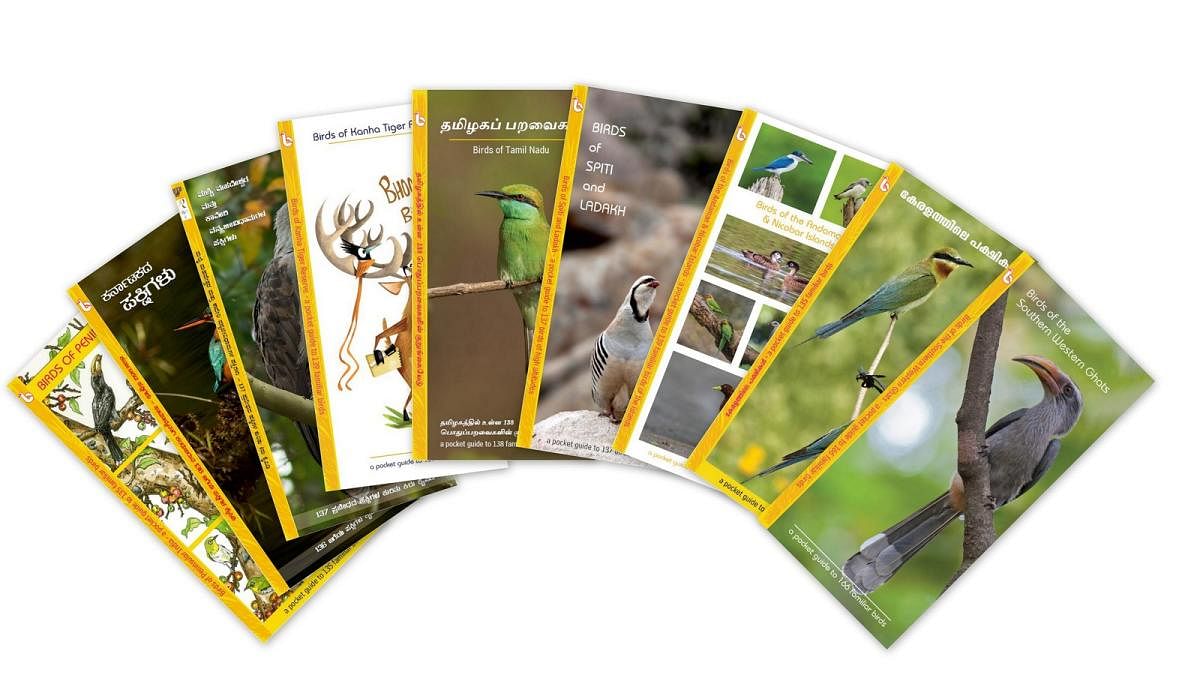

Tigers, lions, elephants, snakes — these are the animals that get the place of pride among children’s toys. Tigers and lions are fierce, elephants are majestic, and snakes are slimy, qualities that make them fascinating to a young child. But what about birds? Beyond crows, hens and pigeons, knowledge about birds is limited among children and adults alike. With its Early Bird initiative, the Nature Conservation Foundation (NCF) hopes to make underrated avians popular among children.
Under this project, artists, conservationists and ornithologists have come together to create educational material to get children interested in birds. This includes a set of flashcards about common Indian birds, pocket guides in English and regional languages, posters, and Bird Bingo!
The material has been put together by Suhail Quader, a scientist, Garima Bhatia, project manager, and Abhisheka Krishnagopal, project associate at NCF. Explaining the idea behind the project, Abhisheka said, “The idea is to create a sense of wonder among children about nature, environment, and about birds. Most of us became ecologists because of that sense of wonder. But children these days do not get to experience much of that.”
Birds and games
And the best way to create this wonder, they felt, was through games. “We have developed many games based on birds. For instance, we have a bird survivor game through which children understand the life cycle of a bird and they learn about migration. We have developed six different games using the flashcards about common Indian birds,” Abhisheka said. Although the games have been developed with children below the age of 15 in mind, Bird enthusiast Vidhya Sundar found that even college students enjoyed playing these games.
Vidhya is a homemaker who runs a small baking business from her lakeside home in Bengaluru. She has been a keen birdwatcher for the past five years, taking time out to look for birds from her terrace. She was looking for ways to take her enthusiasm for birds to the children in her apartment when she came across a workshop conducted by NCF.
“Those who are into birding are usually experts in their field but they don’t know how to communicate their knowledge to children. So we conducted several workshops in Bengaluru, Chennai, Mumbai, Goa, and other places for birders. We gave them the flashcards and pocket guides we had developed and told them how to interact with children,” Abhisheka said.
With training and educational materials in hand, Vidhya set out to introduce children to the joy of birding. She regularly conducts bird walks for children in her neighbourhood and for the students of a local underprivileged school. “There are quite a few lakes in Bengaluru which are good for birding. First, we play games using the flash cards and then we go out to spot birds. Kids get excited to see the birds from the cards in real life,” Vidhya said. She has even conducted a session for her son’s engineering classmates and was met with an equally enthusiastic response.
“When I begin working with them, they know only a few names like crow, pigeon and ostrich. By the end, most of them say they never thought birds could be so interesting. At least a handful of them continue their interest in birds after the session,” Vidhya said. According to her, birding improves their observation and memory skills, besides making them curious about nature.
Murali S says there is an interesting contrast in the understanding rural and urban kids have of birds. “From my observation, children in urban schools usually know the names of birds, even scientific names, but they don’t know much about bird behaviour. It’s the other way round with rural kids. They understand the behaviour but don’t usually know scientific names.” Murali works with children in rural areas outside the city’s limits, introducing them to birds and taking them out on bird walks.
Pocket guides
The pocket guides developed by NCF are indispensable on these bird walks. “Before we got the guides, it was difficult to explain to the children what they should be looking out for,” Murali explained. He uses the bilingual Kannada-English pocket guides because that is what the children are most comfortable with.
“We usually start our sessions by 6 am. First, we tell the children how to use pocket guides. We teach them how to do nature journalling and to sketch the birds they see,” Murali said. The children get to keep the pocket guides and some of them continue birding on their own. “We do follow-up sessions, too. The intention is that children should feel connected with their surroundings. I am an engineer but I got interested in nature and conservation through birding. Hopefully, through these activities children will understand the value of natural resources and care for them in the future,” Murali said.
This is exactly what the team at NCF hopes for. After conducting workshops on the Early Bird materials for birders, they identified that the workshops should also be conducted for school teachers. “Not all birders who attended the workshop actually took the time out to go and train students in schools. We realised that it would be better to directly train school teachers, alongside. So, we are developing training modules for the purpose,” Abhisheka said.
Not all teachers would be able to take children out on bird walks. The materials in the Early Bird programme are designed to get children thinking about birds, even if it is within the confines of a classroom.
The materials of the Early Bird programme, including audio files of bird calls, printable Bird Bingo and posters are available at www.early-bird.in.